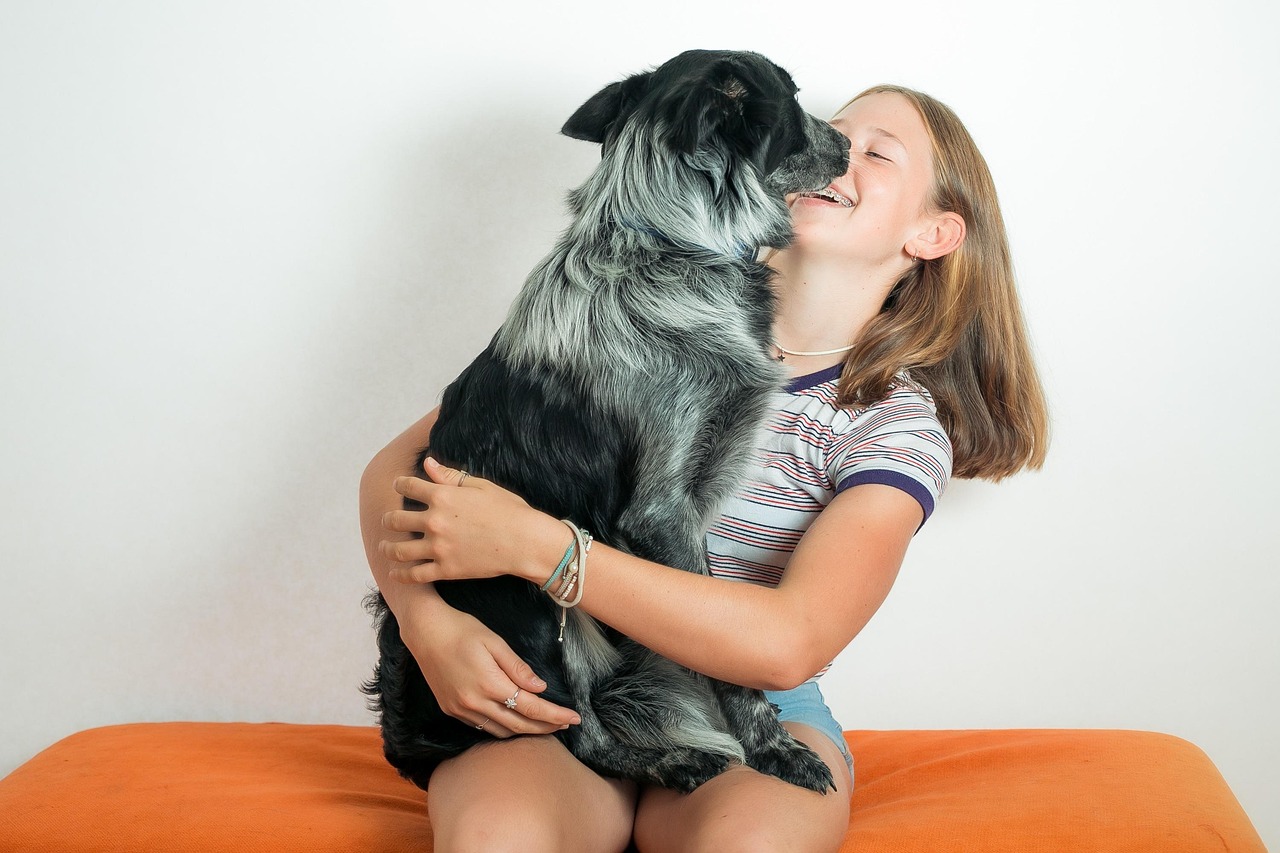This article delves into the important considerations and implications of sharing a bed with your dog. It highlights the benefits, potential drawbacks, and expert recommendations to foster a harmonious sleep environment for both you and your furry friend.
Benefits of Sharing a Bed with Your Dog
- Strengthened Bond: Co-sleeping can enhance the emotional connection between you and your dog, fostering a sense of security and companionship.
- Comfort: Many dog owners find comfort in the presence of their pets, which can lead to reduced anxiety and improved mood.
Potential Drawbacks of Co-Sleeping with Dogs
- Health Concerns: Dogs can carry allergens and parasites, which may pose health risks to humans.
- Sleep Disruptions: Sharing a bed can lead to interrupted sleep patterns for both parties, affecting overall rest quality.
Allergies and Health Concerns
Co-sleeping can exacerbate allergies and skin irritations, especially for sensitive individuals. Regular grooming and cleaning can help mitigate these issues.
Parasites and Zoonotic Diseases
Understanding the risks associated with parasites and diseases that can transfer from dogs to humans is crucial. Regular vet check-ups and preventive treatments are essential.
Impact on Sleep Quality
Sharing a bed may lead to restlessness. To enhance sleep quality, consider establishing a comfortable sleeping arrangement that accommodates both you and your dog.
Creating a Comfortable Sleeping Environment
- Choosing the Right Bedding: Invest in bedding that is easy to clean and durable, ensuring both comfort and hygiene.
- Establishing Boundaries: Clearly define your dog’s sleeping area to maintain personal space and comfort.
When to Consider Separate Sleeping Arrangements
In certain situations, it may be more beneficial for both you and your dog to sleep separately. Recognizing signs of discomfort or restlessness can guide your decision.
Signs Your Dog Needs Their Own Space:
- Increased restlessness during sleep.
- Excessive barking or whining at night.
Alternatives to Co-Sleeping:
If sharing a bed isn’t suitable, consider options like a cozy dog bed or crate training to maintain closeness while ensuring comfort for both.
In conclusion, sharing a bed with your dog can be a fulfilling experience, but it requires careful consideration of the benefits and drawbacks. By following expert recommendations and creating a suitable sleeping environment, you can enjoy a harmonious co-sleeping arrangement.

Benefits of Sharing a Bed with Your Dog
Sharing your bed with your dog can be a deeply rewarding experience that enhances the bond between you and your furry companion. This practice not only offers physical comfort but also fosters emotional connections that can significantly benefit both you and your pet. In this section, we will explore the various emotional and psychological advantages of co-sleeping with your dog.
- Enhanced Bonding: Sleeping together can strengthen the bond between you and your dog. The close proximity allows for increased affection and trust, which can lead to a more secure and loving relationship.
- Comfort and Security: Dogs are known for their loyalty and protective instincts. Having your dog by your side can provide a sense of security, reducing feelings of anxiety and loneliness, especially during the night.
- Stress Reduction: Studies have shown that the presence of a pet can lower stress levels. The act of petting your dog while in bed can release oxytocin, the “love hormone,” which helps to alleviate stress and promote relaxation.
- Improved Sleep Quality: Many dog owners report that having their dog in bed helps them sleep better. The rhythmic breathing of your dog can be soothing, creating a calming atmosphere conducive to restful sleep.
- Emotional Support: For individuals dealing with emotional challenges, having a dog to cuddle with can provide immense comfort. Dogs can sense their owner’s emotions and often respond with affection, helping to improve mood and emotional well-being.
While sharing a bed with your dog can have numerous benefits, it is essential to consider both your comfort and your dog’s needs. Establishing a co-sleeping routine that works for both of you can lead to a harmonious sleeping environment, allowing you to enjoy the many advantages of this close relationship.

Potential Drawbacks of Co-Sleeping with Dogs
While sharing a bed with your dog can be a comforting experience, it is important to recognize the potential drawbacks that may accompany this practice. Understanding these downsides can help you make an informed decision about your sleeping arrangements with your furry friend.
One of the primary considerations when co-sleeping with dogs is the health risks involved. Dogs can carry allergens such as dander, pollen, and dust mites, which may trigger allergies in sensitive individuals. Furthermore, they may also harbor parasites like fleas and ticks, which can pose additional health risks.
Sharing a bed with your dog can lead to sleep disturbances for both parties. Dogs often have different sleep cycles compared to humans, which may result in restlessness during the night. Their movements, snoring, or even barking can disrupt your sleep quality, leaving you feeling fatigued during the day.
Co-sleeping may also contribute to certain behavioral problems in dogs. For instance, dogs may become overly dependent on their owners, leading to issues such as separation anxiety. Additionally, they might develop possessiveness over the bed, making it challenging to establish boundaries.
If you notice that your dog exhibits signs of anxiety, restlessness, or any health issues, it might be time to reconsider your sleeping arrangement. Here are some indicators that separate sleeping arrangements may be more beneficial:
- Frequent disruptions during the night
- Signs of anxiety or distress in your dog
- Allergic reactions or health concerns
In conclusion, while sharing a bed with your dog can foster a strong emotional bond, it is crucial to weigh the potential drawbacks against the benefits. By understanding the health concerns, sleep disruptions, and behavioral issues that may arise, you can create a more harmonious sleeping environment for both you and your pet.
Allergies and Health Concerns
When it comes to sharing your bed with your beloved dog, there are several health concerns that need to be addressed. While the emotional benefits of co-sleeping can be significant, it is essential to consider the potential risks associated with allergies and other health issues.
Dogs can carry allergens such as pollen, dust mites, and dander, which may trigger allergic reactions in sensitive individuals. These allergens can accumulate in your bedding, leading to a range of symptoms including sneezing, itchy eyes, and skin irritations. Regular cleaning of bedding and the dog’s coat can help mitigate these risks.
In addition to allergens, dogs can also harbor parasites like fleas and ticks, which can pose health risks to humans. These parasites can lead to skin irritations and, in some cases, transmit diseases. It is crucial to maintain a regular grooming schedule and use preventive treatments to reduce the likelihood of infestations.
Another concern is the potential for zoonotic diseases, which are illnesses that can be transmitted from animals to humans. Conditions such as ringworm and certain types of bacteria can be passed from dogs to their owners, especially in close quarters like a shared bed. Ensuring your dog is up to date on vaccinations and regular vet check-ups can help minimize these risks.
Moreover, co-sleeping may disrupt your sleep quality. The presence of a dog in the bed can lead to sleep disturbances for both parties, especially if the dog is restless or prone to snoring. It’s important to evaluate your sleep patterns and determine if sharing a bed is affecting your overall well-being.
In conclusion, while there are many benefits to co-sleeping with your dog, it is vital to be aware of the potential health issues that may arise. By taking appropriate precautions, such as maintaining cleanliness and monitoring your dog’s health, you can create a safer and more enjoyable sleeping environment for both you and your furry friend.
Parasites and Zoonotic Diseases
pose significant risks to both dogs and their human companions. Understanding these risks is essential for maintaining a healthy relationship while sharing living spaces, particularly beds. This section delves into the types of parasites and diseases that can be transmitted from dogs to humans and outlines effective strategies to mitigate these risks.
Dogs can carry various parasites, including fleas, ticks, and worms, which may be transmitted to humans. Fleas can cause skin irritations and allergic reactions, while ticks can transmit Lyme disease and other serious illnesses. Moreover, intestinal worms, such as roundworms and hookworms, can be particularly concerning as they can infect humans, especially children, through contact with contaminated surfaces or feces.
In addition to parasites, dogs can also transmit zoonotic diseases such as rabies and salmonella. Rabies is a viral disease that affects the nervous system and is often fatal if left untreated. Salmonella, on the other hand, can be transmitted through contaminated food or surfaces and can lead to gastrointestinal issues in humans.
To minimize the risk of transmission, dog owners should implement several preventive measures:
- Regular Veterinary Check-ups: Ensure your dog receives routine health check-ups and vaccinations to prevent and manage potential diseases.
- Parasite Control: Use veterinarian-recommended flea, tick, and worm prevention treatments to reduce the likelihood of infestation.
- Hygiene Practices: Maintain a clean living environment by regularly washing bedding and cleaning areas where your dog sleeps and plays.
- Hand Washing: Always wash your hands after handling your dog, especially before eating or preparing food.
By taking these precautions, dog owners can enjoy the benefits of sharing a bed with their furry friends while significantly reducing health risks. Awareness and proactive measures are key to ensuring a safe and healthy cohabitation.
Impact on Sleep Quality
Co-sleeping with your dog can be a delightful experience, but it may also disrupt sleep patterns for both humans and their canine companions. Understanding how sharing a bed can affect sleep quality is crucial for ensuring restful nights for everyone involved.
One significant factor to consider is the size and behavior of your dog. Larger breeds may take up more space, leading to discomfort for their human counterparts. Additionally, dogs often move around in their sleep, which can disturb a human’s slumber. This restlessness can manifest in various ways, such as waking up frequently or having trouble falling back asleep.
Moreover, the temperature regulation in bed can be affected when sharing space with a furry friend. Dogs tend to generate heat, which may lead to an uncomfortable sleeping environment for humans, especially in warm weather. This can result in tossing and turning, further impacting sleep quality.
To mitigate these issues and improve sleep quality, consider the following tips:
- Designate a sleeping area: Create a specific space for your dog within the bed that allows for comfort without crowding.
- Use appropriate bedding: Opt for breathable materials that can help regulate temperature and provide comfort.
- Establish a bedtime routine: Consistent routines can help signal to both you and your dog that it’s time to wind down, promoting better sleep.
- Monitor your dog’s behavior: Pay attention to any changes in your dog’s sleeping patterns, as they may indicate discomfort or restlessness that could affect your sleep.
In conclusion, while co-sleeping can enhance the bond between you and your dog, it is essential to be aware of the potential disruptions to sleep quality. By implementing the tips mentioned above, you can create a more harmonious sleeping environment that benefits both you and your furry friend.
Behavioral Considerations
When it comes to sharing a bed with your dog, are crucial for ensuring a harmonious relationship. While the intimacy of co-sleeping can enhance your bond, it may also lead to certain behavioral issues that require attention and management.
One potential concern is the development of separation anxiety. Dogs that sleep in their owner’s bed may become overly dependent, leading to distress when left alone. This anxiety can manifest in various ways, such as excessive barking, destructive behavior, or attempts to escape when the owner is out of sight. To manage this, it is essential to gradually train your dog to feel comfortable being alone. Start with short separations and gradually increase the duration while providing positive reinforcement.
Another issue to consider is dominance behavior. Allowing your dog to sleep in your bed may inadvertently signal to them that they hold a higher social status within the household. This can lead to challenges in obedience and respect for boundaries. To counteract this, it is vital to establish clear rules and boundaries regarding your dog’s behavior in the bed. Consistency is key; ensure that your dog understands their position in the family hierarchy.
Additionally, co-sleeping can sometimes lead to sleep disruptions for both parties. Dogs may move around, snore, or even take up more space than anticipated, which can affect the quality of sleep for their owners. To mitigate this, consider providing your dog with a comfortable dog bed nearby, allowing them to feel close without compromising your sleep quality.
In conclusion, while sharing a bed with your dog can foster a deep emotional connection, it is important to be aware of the potential behavioral challenges that may arise. By implementing training techniques and establishing clear boundaries, you can enjoy the benefits of co-sleeping while minimizing any negative impacts on your dog’s behavior.

Creating a Comfortable Sleeping Environment
When considering sharing your bed with your dog, it is crucial to create a comfortable and safe sleeping environment. A harmonious co-sleeping arrangement not only enhances your bond but also ensures a restful night for both you and your furry companion. Below are some practical tips to help you achieve this.
- Choose the Right Bedding: Opt for bedding materials that are both comfortable and easy to clean. Look for hypoallergenic options to minimize allergens. Consider using a waterproof cover to protect your mattress from any accidents.
- Establish Boundaries: Setting clear boundaries can help maintain personal space. Designate specific areas on the bed for your dog, ensuring they have their own spot while still being close to you.
- Create a Sleep Routine: Dogs thrive on routine. Establish a consistent bedtime routine that signals to your dog when it’s time to sleep. This could include a short walk or some quiet time before bed.
- Temperature Control: Ensure that the sleeping environment is comfortable in terms of temperature. Dogs can be sensitive to heat and cold, so adjust bedding and room temperature accordingly.
- Regular Grooming: Keeping your dog well-groomed can reduce shedding and allergens in your sleeping area. Regular baths and brushing help maintain cleanliness and comfort.
- Monitor Health: Regular vet check-ups are vital to ensure your dog is healthy and free from parasites. This can help prevent health issues that may arise from co-sleeping.
By implementing these strategies, you can create a safe and cozy sleeping environment that benefits both you and your dog. Ultimately, the goal is to foster a peaceful sleeping arrangement that enhances your relationship while ensuring both parties get the rest they need.
Choosing the Right Bedding
for you and your dog is essential not only for comfort but also for maintaining good hygiene. The right bedding can create a cozy environment that promotes restful sleep for both you and your furry friend. Here, we delve into various materials and types of bedding suitable for dog owners, ensuring a harmonious co-sleeping experience.
- Material Matters: When selecting bedding, consider materials that are both durable and easy to clean. Natural fibers like cotton and linen are breathable and hypoallergenic, making them excellent choices for pet owners. They can help reduce the risk of allergens and provide a comfortable sleeping surface.
- Water-Resistant Options: If your dog tends to drool or has occasional accidents, look for water-resistant bedding. These types of bedding are designed to repel moisture, protecting your mattress and ensuring hygiene.
- Washable Covers: Opt for bedding with removable and washable covers. This feature allows for easy cleaning and maintenance, ensuring that your sleeping area remains fresh and free from pet odors.
- Thickness and Support: Consider the thickness of the bedding. A mattress that offers adequate support is crucial for both you and your dog. Look for memory foam or orthopedic mattresses that provide comfort and help alleviate pressure points.
- Dog-Specific Bedding: If you decide to have separate sleeping arrangements, invest in a quality dog bed. Look for options that cater to your dog’s sleeping style, whether they prefer to curl up or stretch out. Orthopedic dog beds can be particularly beneficial for older dogs.
In conclusion, selecting the right bedding is a critical aspect of creating a comfortable and hygienic sleeping environment for both you and your dog. By considering materials, ease of cleaning, and the specific needs of your pet, you can ensure a restful night for everyone involved.
Establishing Boundaries
When sharing your bed with your dog, establishing clear boundaries is essential for a harmonious co-sleeping experience. This practice not only helps maintain your personal space but also contributes to your dog’s comfort and well-being. Here are some effective strategies to set boundaries that ensure both you and your furry friend enjoy restful nights.
- Designate a Specific Area: Create a designated sleeping spot for your dog within the bed. Use a dog bed or blanket to mark this area, helping your dog understand where they should sleep.
- Teach Commands: Utilize basic commands such as “stay” or “place” to reinforce where your dog is allowed to sleep. Consistent training can help your dog respect the boundaries you set.
- Use Barriers: Consider using soft barriers, such as pillows or cushions, to physically separate your space from your dog’s. This can prevent them from encroaching on your side during the night.
- Monitor Behavior: Pay attention to your dog’s sleeping habits and adjust boundaries as needed. If they tend to invade your space, gently redirect them to their designated area.
- Positive Reinforcement: Reward your dog when they respect the boundaries you’ve established. Treats, praise, and affection can encourage them to maintain their designated sleeping position.
By implementing these strategies, you can create a comfortable and peaceful sleeping environment for both you and your dog. Remember that consistency is key; the more you reinforce these boundaries, the more likely your dog will adapt to them. Establishing boundaries not only enhances your personal space but also fosters a sense of security for your dog, making co-sleeping a positive experience for both parties.

When to Consider Separate Sleeping Arrangements
When it comes to sharing your bed with your dog, there are several factors to consider. While many pet owners enjoy the closeness and comfort that co-sleeping provides, there are specific situations where it may be more beneficial for both you and your furry friend to have separate sleeping arrangements. This section delves into those scenarios, helping you make an informed decision.
Recognizing when your dog might require their own sleeping area is crucial for their well-being. Here are some key indicators:
- Restlessness: If your dog frequently shifts positions or seems unable to settle down, it may indicate discomfort in your shared sleeping space.
- Excessive Barking or Whining: Vocalizations during the night can disrupt your sleep and suggest that your dog feels anxious or unsettled.
- Overheating: Dogs can easily become too warm when sharing a bed, especially larger breeds. If your dog seems to be panting or restless due to heat, separate arrangements might be necessary.
- Behavioral Changes: Sudden changes in behavior, such as increased aggression or anxiety, can be a sign that your dog needs more personal space.
If you determine that co-sleeping is not the best option, there are several alternatives that allow you to maintain closeness with your dog:
- Dog Beds: Invest in a comfortable dog bed placed near your bed. This allows your dog to feel secure while having their own space.
- Crate Training: A crate can serve as a cozy retreat for your dog. Proper crate training can create a positive association, making it a safe haven for them.
- Designated Sleeping Areas: Setting up a specific area in your bedroom for your dog can help them feel included without sharing the bed.
Ultimately, the decision to co-sleep or provide separate sleeping arrangements should be based on the individual needs of both you and your dog. By being observant and responsive to their behavior, you can create a comfortable and peaceful sleeping environment for everyone involved.
Signs Your Dog Needs Their Own Space
Understanding your dog’s sleeping habits is crucial for their well-being and your own comfort. While many pet owners enjoy the closeness of sharing a bed with their furry companions, there are times when a dog may require their own sleeping area. Recognizing the signs that your dog needs their own space can help ensure a restful night for both you and your pet.
- Restlessness During Sleep: If your dog frequently shifts positions, whines, or seems unable to settle down, it may indicate discomfort. This behavior can suggest that they need a separate space to relax without interruptions.
- Excessive Heat: Dogs can generate a lot of body heat, especially larger breeds. If you notice your dog panting or seeking cooler spots during the night, it might be a sign they need their own sleeping area to regulate their temperature.
- Increased Aggression or Anxiety: If your dog displays signs of aggression or anxiety when sharing your bed, it could be a warning sign. Dogs that feel territorial or anxious may benefit from having their own designated sleeping area.
- Interruptions to Your Sleep: If you find yourself waking frequently due to your dog’s movements or sounds, it may be time to consider separate sleeping arrangements. A good night’s sleep is essential for both you and your dog.
- Age-Related Changes: As dogs age, they may develop conditions such as arthritis or other ailments that make it difficult for them to climb into bed or get comfortable. Providing them with a separate, cozy sleeping area can be more beneficial for their health.
By paying attention to these behaviors, you can make informed decisions about your dog’s sleeping arrangements. If you observe any of these signs, it may be time to create a comfortable sleeping space for your dog, ensuring that both of you can enjoy restful nights.
Alternatives to Co-Sleeping
When co-sleeping with your dog is not the best option, there are several alternatives that can maintain the bond between you and your furry friend while ensuring a comfortable and safe sleeping environment for both. This section delves into practical solutions like dog beds and crate training, offering a balanced approach to pet ownership.
Dog Beds
Investing in a high-quality dog bed is one of the most effective alternatives to co-sleeping. A dedicated dog bed provides your pet with a cozy space of their own, which can help to:
- Enhance Comfort: Choose a bed that suits your dog’s size and sleeping style. Orthopedic beds are particularly beneficial for older dogs or those with joint issues.
- Encourage Independence: By having their own space, dogs can learn to relax and sleep independently, which is essential for their mental well-being.
- Improve Hygiene: A designated bed can minimize allergens and dirt in your sleeping area, promoting a healthier environment for both you and your dog.
Crate Training
Crate training is another excellent alternative that can provide your dog with a secure and comfortable space. Here are some benefits of crate training:
- Safety: A crate can keep your dog safe during the night, especially if they are prone to chewing or getting into things.
- Security: Many dogs find comfort in a crate, as it mimics a den-like environment where they can feel secure.
- House Training: Crate training can assist in house training, as dogs naturally avoid soiling their sleeping area.
Ultimately, whether you choose a dog bed or crate training, the goal is to create a loving and secure environment for your dog. These alternatives not only foster a sense of closeness but also promote better sleep quality for both you and your pet.













